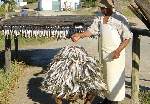
 |
Route 27 West Coast South AfricaThe Fishing Industry |
West Coast R27 Route 27 West Coast Towns Off the Beaten Track West Coast History Culture & History From Crayfish to Iron West Coast Map West Coast Explorer SA West Coast Tours/Recreation Nature Reserves Fossil Park Sea Tales & Wrecks Whale Watching Weskus Stories |
 South Africa's fishing industry has a long and eventful history. As early as 1658, a mere six years after the first permanent settlement at the Cape, four free burghers were given permission to settle in Saldanha Bay. They established themselves as fishermen and sold dried fish to the other burghers as well as to passing ships. South Africa's fishing industry has a long and eventful history. As early as 1658, a mere six years after the first permanent settlement at the Cape, four free burghers were given permission to settle in Saldanha Bay. They established themselves as fishermen and sold dried fish to the other burghers as well as to passing ships.Today, three centuries later, the once unlimited fish stocks have been placed under such pressure through wastage and over-exploitation that it has become necessary to protect them from total decimation. As a result, the government has reduced catch quotas drastically across the whole industry. The number of fish meal and fish oil processing plants has also been reduced. The visitor to Saldanha, St Helena Bay or West Point will see the number of factories strung out along the coast. In these, the region's marine wealth is canned or processed into fish oil and fish meal. In 1956 the industry started to regulate itself by forming a company for the centralised marketing and sale of canned fish products. Fish Factories Among the sizable companies in the region, Sea Harvest is the largest employer of labour in Saldanha. In this giant factory everything is geared to unloading and processing the cargo of fish from each boat as quickly as possible. Boats sail hundreds of kilometres into the open sea to net fish at great depths. Some of the larger factory ships may remain away from home port for as long as three months at a time. Among the sizable companies in the region, Sea Harvest is the largest employer of labour in Saldanha. In this giant factory everything is geared to unloading and processing the cargo of fish from each boat as quickly as possible. Boats sail hundreds of kilometres into the open sea to net fish at great depths. Some of the larger factory ships may remain away from home port for as long as three months at a time.Apart from processing and packaging the fish, these factories also produce instant precooked meals. Ships regularly dock at Saldanha from all over the world - from as far away as Norway - to load table-ready products for export. These products are being marketed as far afield as Russia and countries in the East. Two types of fishing boats are used: there are factory ships with freezing facilities where fish is processed on board ship and there are fresh fish trawlers which net fish at depths of 350 m to 800 m. The Dried Fish Industry The preparation and drying of fish for export has grown by leaps and bounds, especially in response to the growing demand for the product from South Africa. The preparation and drying of fish for export has grown by leaps and bounds, especially in response to the growing demand for the product from South Africa.Fish has been dried in this region with its dry summers for a long time and the well-known Cape Bokkom - a salted, dried mullet (several species belong to the Mugilidae family) - has been a cheap and practical source of protein for centuries. Supplying the market with a product at an affordable price was admirably filled by the pelagic horse mackerel (Trachurus trachurus). It fitted the required specifications for moisture content, salt concentration and other health standards.
Author - Cornel Truter, West Coast Tourist Guide
|